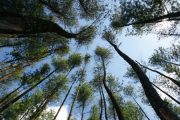I have never been fond of travelling alone and so this adventure filled me with some anxiety, even though friends would be close by, at my holiday destination. Throwing caution to the wind I packed my bags, loaded my new banjo into my Saturn and headed south.
After a two days’ drive, I reached my little cottage on the banks of the Weeki Wachee River, a small shallow stream that snakes its way westward to the Gulf of Mexico, 12 miles away. The cottage was located in a quiet town with plenty of interesting sites to visit. During my month’s stay the highlight for me was kayaking with my friend. We paddled for several miles down the Weeki Wachee River, taking several rests along the way to observe our surroundings and swim in the shallow water. Kayaking on a gentle river was a pleasant way to spend an afternoon.
During warm, sunny afternoons I often sat by the Weeki Wachee on an old wooden swing, with my banjo on my lap. But I was at a total loss when it came to anything resembling a tune. On occasion I hummed Stephen Foster’s famous song, Way Down Upon the Swanee River. It just seemed appropriate.
The banjo has a long, somewhat clouded history according to historians who have researched its origins. Some researchers claim that it came from West Africa. It started out as hide-covered stringed instruments called the ngoni and the xalam and over hundreds of years evolved from there.
After my struggle to learn the rudimentary skills needed to play the banjo, it has always puzzled me how easily tens of thousands of dirt-poor, uneducated African-American slaves taught themselves and each other to play this instrument so well. Their long tradition of being closely connected with this instrument may be the answer. Historians claim that their ancestors brought a version of this instrument with them when they were forced into slavery and brought to the southern United states to work on the cotton plantations.
In America it eventually became a popular part of the African-American traditional music and the rural white folk culture before going mainstream via the minstrel shows of the 19th century. It was paired with the fiddle to dominate old-time music and later often used when playing traditional jazz.
Except for posing for some photos with my banjo I finally gave up any attempt at teaching myself to play. At the end of my stay, I packed it away for the long journey home. Although I had managed to avoid a month of cold Canadian winter it wasn’t a particularly enjoyable holiday. Even more disappointing was the fact that I had failed miserably to make the slightest progress with my banjo.
Soon after arriving home I became determined to pursue my quest to play the banjo. I found a music teacher and signed up for a series of weekly banjo lessons to see if I could make progress. The tutor was good. He suggested playing the banjo right-handed. It proved fairly easy to strum the banjo with that hand. It was not nearly as awkward as holding the bow in my right hand. My hopes began to rise, but the lessons ended when I decided to downsize and move from my Caledon country home to Dundas. After my move the banjo lay in a closet for several years while other priorities occupied me.





Valerie McDonald5 years ago
Your persistence paid off! I enjoyed the song titles and history of the banjo–and the photo!